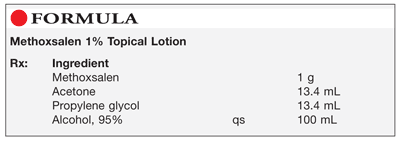US Pharm. 2012;37(6):48-49.

Method of Preparation: Calculate the quantity of each ingredient for the amount to be prepared. Accurately weigh or measure each ingredient. Dissolve the methoxsalen in the propylene glycol, acetone, and about 65 mL of alcohol. Add sufficient alcohol to final volume and mix well. Package and label.
Use: Methoxsalen is used topically in the treatment of idiopathic vitiligo. It was formerly used topically with ultraviolet A light for the treatment of psoriasis, but this practice has mostly been discontinued because of adverse effects.
Packaging: Package in tight, light-resistant containers.
Labeling: Shake well before using. Keep out of the reach of children. For external use only. For professional use only. Discard after 6 months.1
Stability: A beyond-use date of 6 months may be used for this preparation.1
Quality Control: Quality-control assessment can include weight/volume, pH, specific gravity, active drug assay, color, clarity, rheologic properties/pourability, physical observation, and physical stability (discoloration, foreign materials, gas formation, mold growth).2
Discussion: Methoxsalen topical lotion has been in short supply, but it can be compounded by pharmacists during the time of shortage. This topical solution occasionally may be diluted 10- to 100-fold to avoid excessive reactions. It should be applied only to small, well-defined, vitiliginous lesions by a physician; it should not be dispensed to a patient for home use. Protect the hands and fingers of the caregiver with gloves or finger cots to avoid photosensitization and possible burns.3
Methoxsalen (Oxsoralen, C12H8O4, MW 216.19) occurs as white to cream-colored, fluffy, needle-like, odorless crystals. It is soluble in acetone, boiling alcohol, and propylene glycol, and is practically insoluble in water. Methoxsalen should be preserved in well-closed, light-resistant containers. It melts between 143°C and 148°C and contains not more than 0.5% water.1
Methoxsalen Topical Solution USP is a clear, colorless liquid. It contains not less than 9.2 mg and not more than 10.8 mg of methoxsalen per mL. Methoxsalen Topical Solution should be preserved in tight, light-resistant containers. It contains between 66.5% and 77.0% of C2H5OH.1
Acetone (2-propanone, C3H6O, MW 58.08) occurs as a transparent, colorless, mobile, volatile liquid with a characteristic odor. A 50% aqueous solution is neutral to litmus. Acetone is miscible with water, alcohol, ether, and most volatile oils. It has a specific gravity of not more than 0.789 and a boiling point of about 56°C. Acetone is used as a solvent.1
Propylene glycol (C3H8O2) occurs as a clear, colorless, viscous, practically odorless, sweet-tasting liquid, somewhat resembling glycerin. Propylene glycol has a specific gravity of 1.038 g/mL and is miscible with acetone, chloroform, 95% ethanol, glycerin, and water. It is not miscible with fixed oils or light mineral oil; it will, however, dissolve some essential oils. A 2% v/v aqueous solution of propylene glycol will be iso-osmotic with serum. Propylene glycol is used as a humectant in topicals (~15% concentration); as a preservative in solutions and semisolids (15%-30% concentration); and as a solvent or cosolvent in aerosols (10%-30% concentration), oral solutions (10%-25% concentration), parenterals (10%-60% concentration), and topicals (5%-80% concentration). Propylene glycol is a better solvent than glycerin. It is similar to ethanol as an antiseptic, and it is also used in cosmetics and in the food industry as a vehicle for flavors and emulsifiers. It is stable and may be mixed with numerous other solvents. Since propylene glycol is hygroscopic, it should be stored in an airtight container and protected from light. Incompatibilities include potassium permanganate.4
Alcohol (ethyl alcohol, ethanol, grain alcohol, C2H5OH, MW 46.07) is a clear, colorless, mobile, volatile liquid with a slight, characteristic odor and a burning taste. It is used as an antimicrobial preservative (>10% concentration), as a disinfectant (60%-90% concentration), and as a solvent in injectable and oral liquids (variable concentration) and topical products (60%-90% concentration). Alcohol USP refers to 95% ethanol, and dehydrated alcohol refers to 99.5% alcohol. Alcohol’s specific gravity is between 0.812 and 0.816, and its boiling point is 78.15°C. It should be stored in a cool place. Alcohol is incompatible with oxidizing materials in acidic conditions. With alkalies, it may darken in color. When alcohol is added to aqueous solutions of organic salts or acacia, they may precipitate. Alcohol is incompatible with aluminum containers, and it may interact with some drugs.5
REFERENCES
1. U.S. Pharmacopeia 35/National Formulary 30. Rockville, MD: U.S. Pharmacopeial Convention, Inc; 2012:344-350,350-386,1098,1129,3859-3861.
2. Allen LV Jr. Standard operating procedure for performing physical quality assessment of oral and topical liquids. IJPC. 1999;3:146-147.
3. Properties of alcohol. www.ahfsdruginformation.com/support/not_in_print/a382384.aspx. Accessed May 8, 2012.
4. Weller PJ. Propylene glycol. In: Rowe RC, Sheskey PJ, Quinn ME, eds. Handbook of Pharmaceutical Excipients. 6th ed. London, England: Pharmaceutical Press; 2009:592-594.
5. Quinn ME. Alcohol. In: Rowe RC, Sheskey PJ, Quinn ME, eds. Handbook of Pharmaceutical Excipients. 6th ed. London, England: Pharmaceutical Press; 2009:17-19.
To comment on this article, contact rdavidson@uspharmacist.com.





